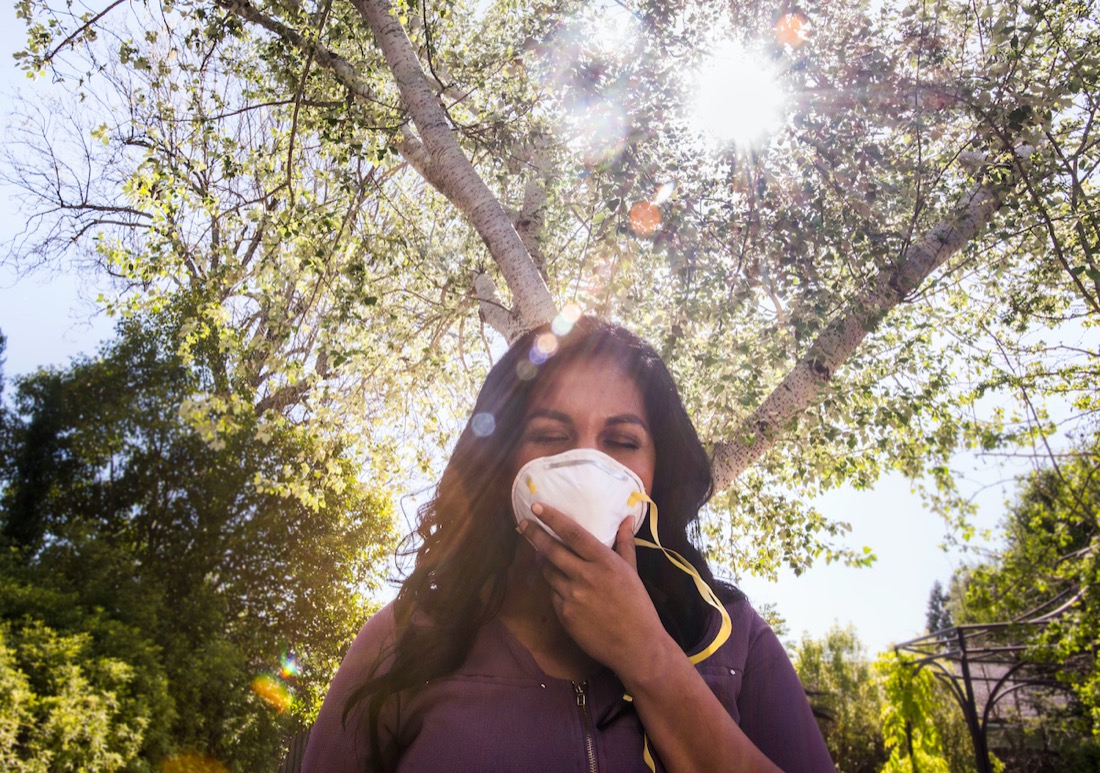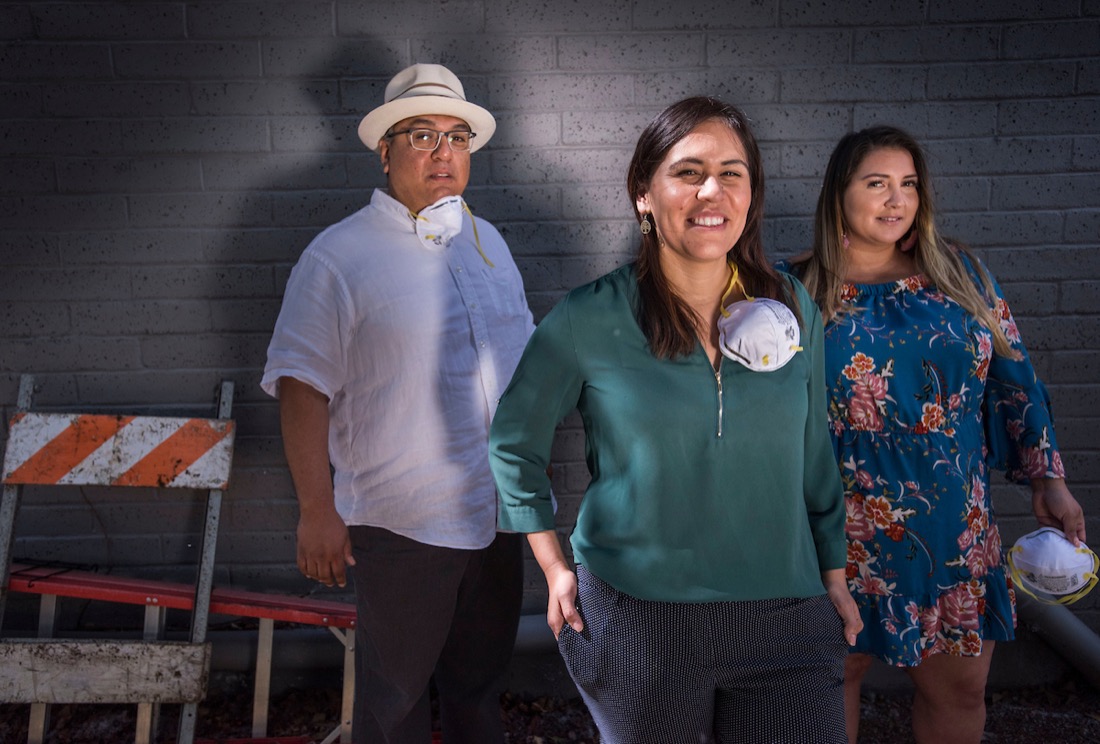Latinos In The West Are Twice As Likely To Be Affected By Wildfires
4:06 minutes

 This piece was created in partnership with Currently. The story below is written by Currently’s Abbie Veitch.
This piece was created in partnership with Currently. The story below is written by Currently’s Abbie Veitch.
A housing crisis, mixed with the location of farmwork and frontline jobs that attract Latino residents, particularly migrant workers, have put the community at greater risk of being impacted by wildfires, California activists and experts say.
According to reporting by Politico, which analyzed data from risQ, “The Latino population makes up about 18 percent of the U.S. but represents 37 percent of the people who live in the areas that risQ identified as facing the most extreme wildfire risks.”
José Trinidad Castañeda, a climate activist in Orange County who serves as the Beautification and Environmental Commissioner for the city of Buena Park, says that in order to address the wildfire issue, California must address its housing crisis.
“Climate does not discriminate, but our housing crisis has,” said Trinidad Castañeda.
Trinidad Castañeda said that many members of his family have continually moved farther toward the desert and more rural regions which are more susceptible to wildfires.
Homes in wildfire-prone areas are cheaper than homes in safer areas, and this has only worsened during the pandemic. Trinidad Castañeda said that many Latinos he knows spend hours commuting to get to work.
Susanna Ramirez, an associate professor of public health communication at the University of California whose research focuses on advancing public health goals for rural and Latino populations, echoed Trinidad Castañeda’s thoughts.
“People who make what used to be solid middle income salaries — like teachers and firefighters, people that you want and need to live in a community — can’t afford housing, and so they have migrated farther and farther inland,” said Ramirez. ”It’s sort of a ripple effect of making it increasingly more expensive for families with low paying jobs to have a foothold on the American dream.”
She said that the issues surrounding wildfires are one of the most significant public health crises people face, including the obvious effects of fires such as evacuation, loss of homes and poor air quality, which exacerbates other respiratory illnesses. But other harmful effects, albeit less obvious, can include the loss of school days and time spent outside.
Ramirez said that these issues are worse for Latino families and communities. Many Latino families live in multi-generational households that include both ends of that vulnerable age spectrum, she said. And Latino families are more likely to take difficult low-paying jobs because they are in structurally vulnerable positions.
“The counties that face really high risks of wildfires also have happened to have a large proportion of Latinos. These are rural and agricultural regions where Latinos work in the fields where they harvest produce or in meat processing plants,” Ramirez said.
Wildfires are already raging in the West, and scientists are expecting it to be one of the worst seasons yet. Climate change-fueled droughts and record-breaking heat waves have heightened the risk of fires.
Masha Chernyak, the senior vice president of programs at the Latino Community Foundation, said that she has seen how wildfires have hurt Latino communities across California. Latino Community Foundation works to empower and uplift Latino people in California. It currently invests in and connects Latino-led organizations across the state.
“There’s so much exploitation in our communities, especially in the Latino farmworker communities in places like Sonoma Central Valley,” said Chernyak. “These are the communities that fed us through the pandemic, literally made sure we had food on our tables. We all talk about how Latinos were essential, but when are we actually going to treat them as such? When are we going to actually prioritize them?”
Indira López, the program director for UpValley Family Centers, a community resource center in Napa Valley, said that while it is upsetting to see the disparities between her Latino community members and the tourists who visit, the strength and generosity from her community keeps her afloat.
“It’s a beautiful place where tourists come and enjoy themselves, and they come to the wine industry. But underneath, there is another reality, which is the reality of the workers. The disparities and inequalities that still affect people living here,” said López “The other part is the beauty of the people and how despite the circumstances, they find a way to help each other.”
While solving the housing crisis would be the ideal solution, many community leaders said they first need information in Spanish and other native languages to be spread through trusted sources. And community members who may be undocumented need to know that they are safe while seeking assistance.
Angie Sanchez is a community leader in Sonoma who previously worked with Corazon and La Luz Center, two Latino community organizations. She is now starting her own community nonprofit called Vida, which translates to Life.
Through her work, she’s seen that the best results come from active community engagement, and the best people to do that work are folks already embedded in the community, Sanchez said.
“I think the number one thing is outreach and engaging the community. We should not wait for individuals to come to us when the disaster is already happening. We need to be more preventive.”

Latino Community Foundation’s Chernyak said that during the last wildfire, the group’s staff visited evacuation sites in Sonoma and saw what the opposite of effective disaster relief for Latino folks looked like.
“They did not have signage in Spanish, they did not have bilingual staff and there was a police officer there for security. [My coworker] saw people sitting in the parking lot, afraid to go in and didn’t know what to do,” Chernyak said.
The people most effective at reaching the most vulnerable are the people who are deeply embedded in the community like these organizers, she said.
“They are so closely connected to the issues because they are the community. So when crisis hits, they are the first responders. They are the ones to give people information resources to organize folks.”
Both Sanchez and López said that they have worked on emergency wildfire response. They brought laptops and supplies with them while they were being evacuated from their own homes.
“The Latino community is the most resilient group of individuals that I know. I love that during any type of emergency, everybody comes together as a community, as a family. Everybody’s there for one another,” Sanchez said.
Invest in quality science journalism by making a donation to Science Friday.
Abbie Veitch is Editor in Chief at Currently.
IRA FLATOW: This is Science Friday. I’m Ira Flatow. The western half of the country has been experiencing record-breaking wildfire seasons. Last year in California, nearly 10,000 fires burned over 4 million acres in the state, destroying land and wildlife, but also homes and entire communities.
And certain communities are disproportionately affected. According to the climate service firm risQ, Latinos make up 18% of the US population but 37% of the population that face extreme wildfires. In California, according to California activists and experts, a housing crisis mixed with the location of farm work and front-line jobs that attract Latino residents, especially migrant workers, has put the community at greater risk.
ABBIE VEITCH: A lot of folks described a situation where they’re sort of in this cycle.
IRA FLATOW: That’s Abbie Veitch, editor-in-chief of Currently, a weather and climate newsletter. She’s covering this story.
ABBIE VEITCH: Housing is too expensive so they move somewhere with accessible jobs and affordable housing. But those affordable homes are in these more wildfire-prone areas. They’re more likely to lose their homes and have poor health effects. And I think a lot of people are frustrated. But they’re also just worn down from being stuck in this cycle.
IRA FLATOW: Farm workers and other residents affected by the housing crisis can feel like they have no place to go.
JOSÉ TRINIDAD CASTANEDA: Climate does not discriminate, but our housing crisis has.
IRA FLATOW: That’s José Trinidad Castaneda. He’s a climate activist in Orange County. And he’s seen this housing cycle happen in his own family.
JOSÉ TRINIDAD CASTANEDA: When I hear my family members talk about how it’s very unaffordable to live in Orange County or even Riverside, and they’re moving out towards high desert regions like Apple Valley, then I’m not surprised that the further out they move and closer to some of the rural areas of California in the west, the more impacted they are by fires and climate impacts like drought.
IRA FLATOW: Solving the housing crisis would be the ideal solution. But during a wildfire emergency, more immediate personal safety issues need to be at the forefront. And that can be a challenge in aiding an isolated Latino community. Angie Sanchez has worked with Latino community organizations in Sonoma and has worked on emergency wildfire response in the area.
ANGIE SANCHEZ: I think the number one thing is the outreach, engaging the community. You should not wait for individuals to come to us when the disaster is already happening. We need to be more preventive in letting the community of the resources, where are the evacuation centers, where are the shelters, and just really being there and available.
IRA FLATOW: Communicating this information is vital. But language can be a barrier. And that means the government needs to disseminate information in Spanish and Indigenous languages through trusted sources in the community, according to organizers.
Also police presence at evacuation centers, especially for undocumented people, can be a huge impediment causing people to turn away from resources that do exist. So organizations are working to ready communities before a wildfire disaster strikes. Here’s Abbie.
ABBIE VEITCH: They’re working on training community members on how to help their neighbors and families to prepare for crisis. They’re also working to ensure folks know about how to access resources like renters insurance and disaster preparedness kits prior to crisis so they’re not scrambling when the fire is already at their doorstep.
IRA FLATOW: You can read Abbie Veitch’s entire Currently article. It’s up on our website at ScienceFriday.com and you can sign up for more Currently stories at Currently HQ.com.
Copyright © 2021 Science Friday Initiative. All rights reserved. Science Friday transcripts are produced on a tight deadline by 3Play Media. Fidelity to the original aired/published audio or video file might vary, and text might be updated or amended in the future. For the authoritative record of Science Friday’s programming, please visit the original aired/published recording. For terms of use and more information, visit our policies pages at http://www.sciencefriday.com/about/policies/
 A selection of Science Friday’s podcasts, teaching guides, and other resources are available in the LabXchange library, a free global science classroom open to every curious mind.
A selection of Science Friday’s podcasts, teaching guides, and other resources are available in the LabXchange library, a free global science classroom open to every curious mind.
Alexa Lim was a senior producer for Science Friday. Her favorite stories involve space, sound, and strange animal discoveries.
Ira Flatow is the host and executive producer of Science Friday. His green thumb has revived many an office plant at death’s door.